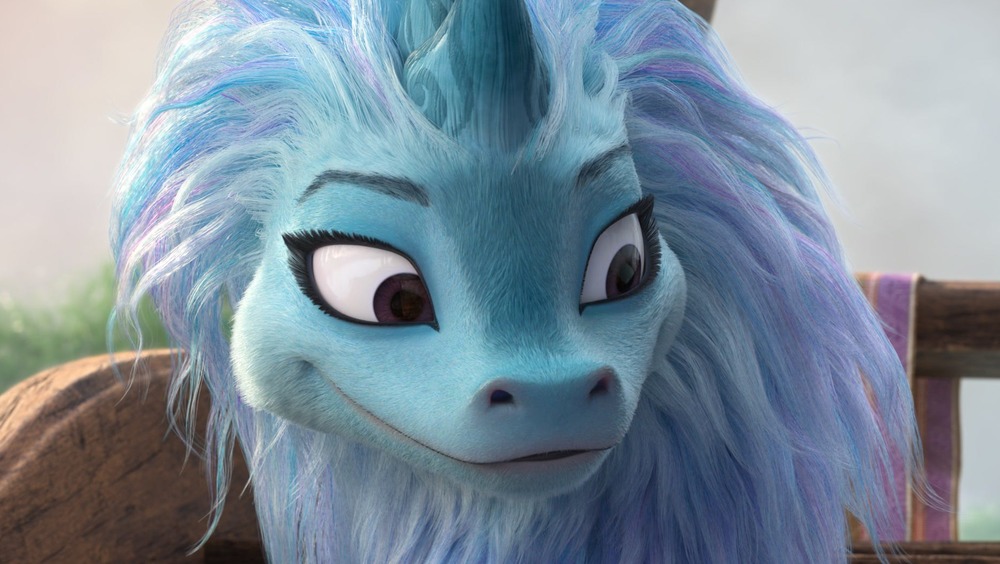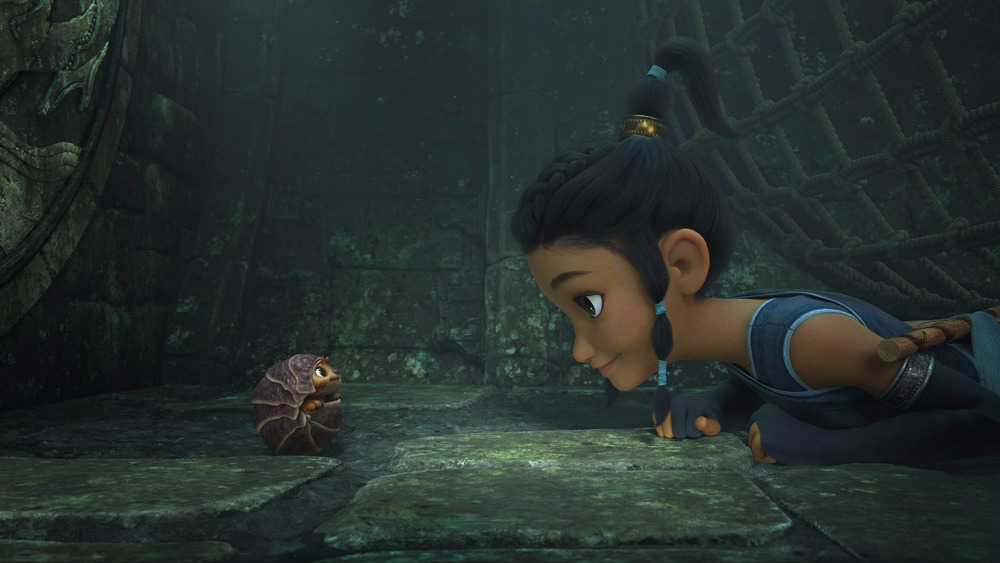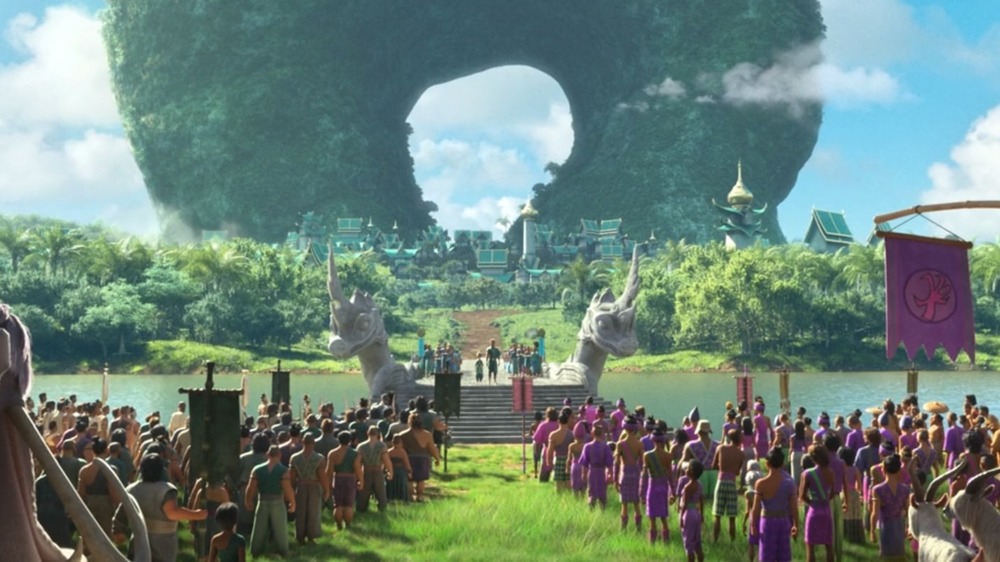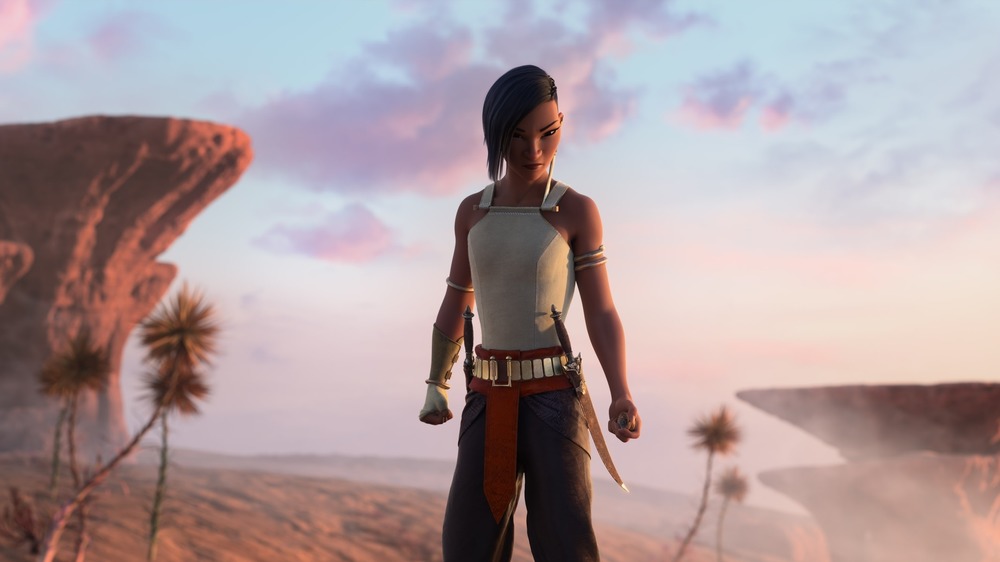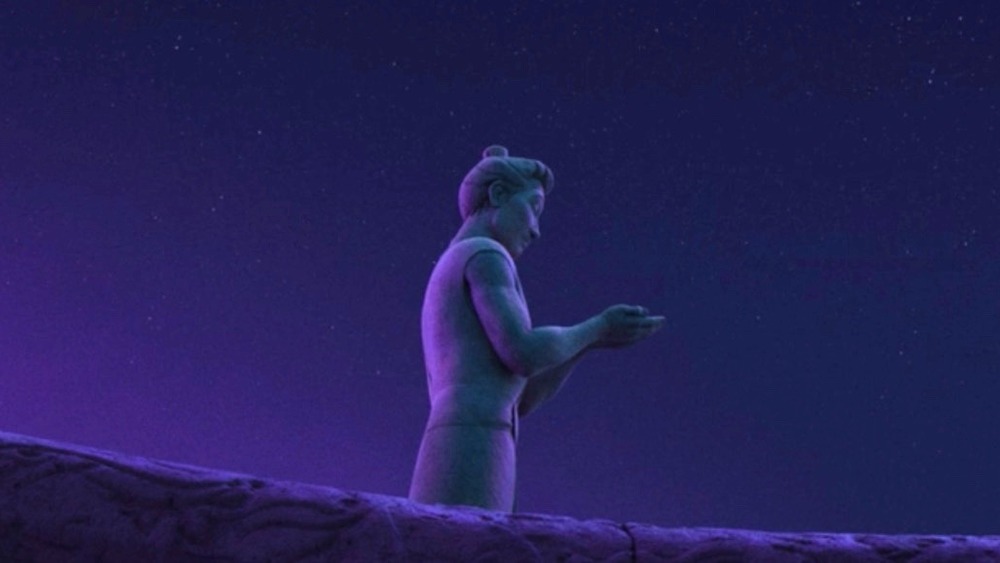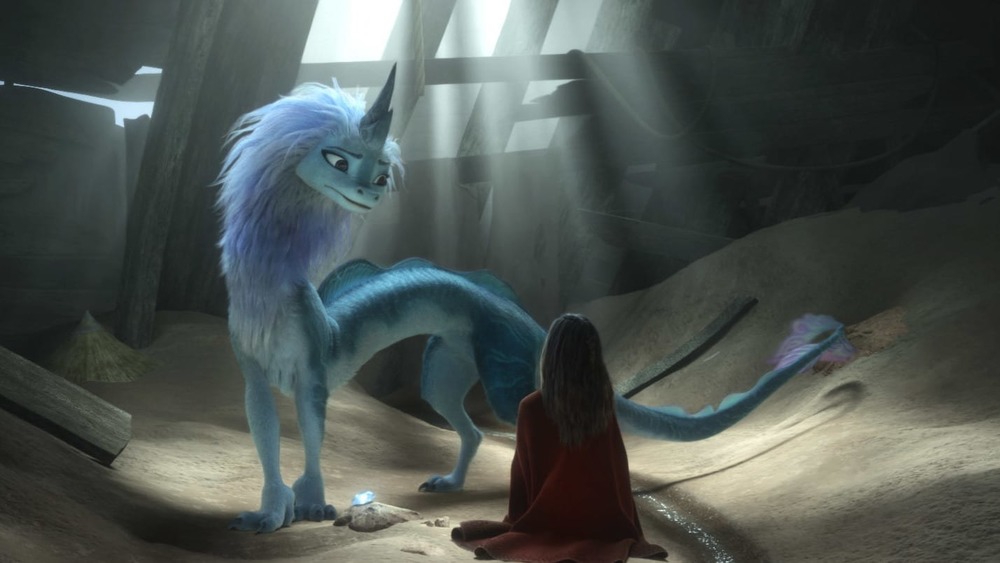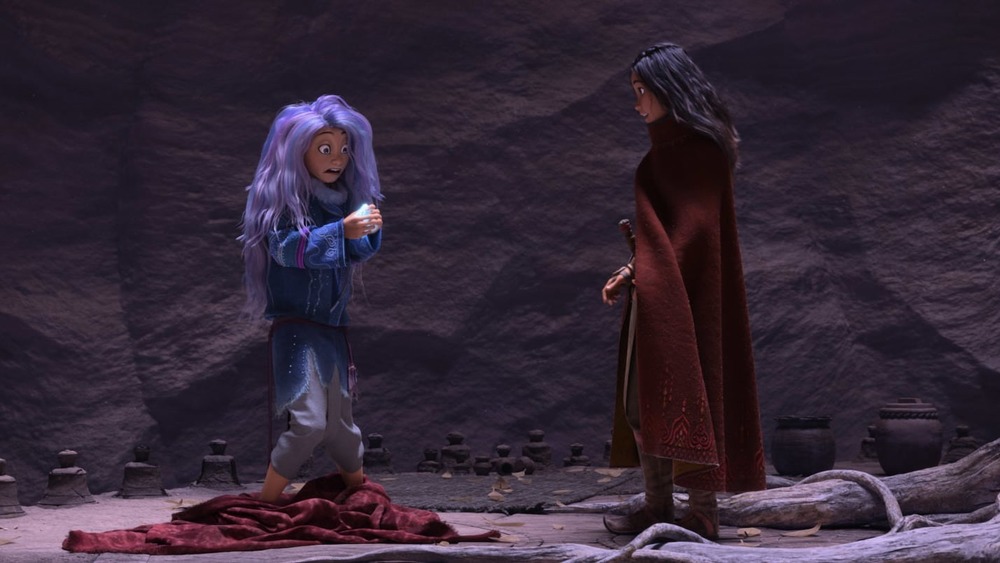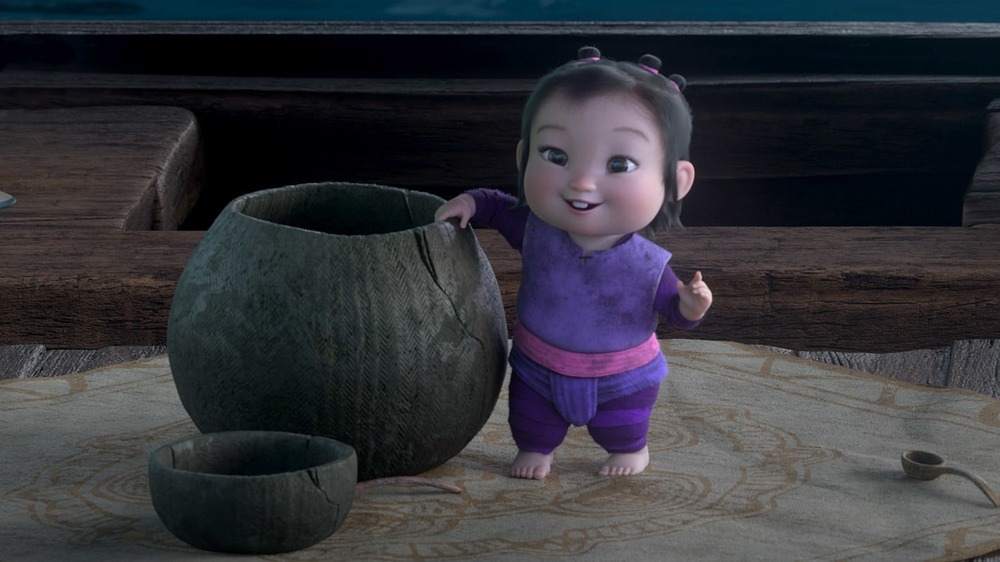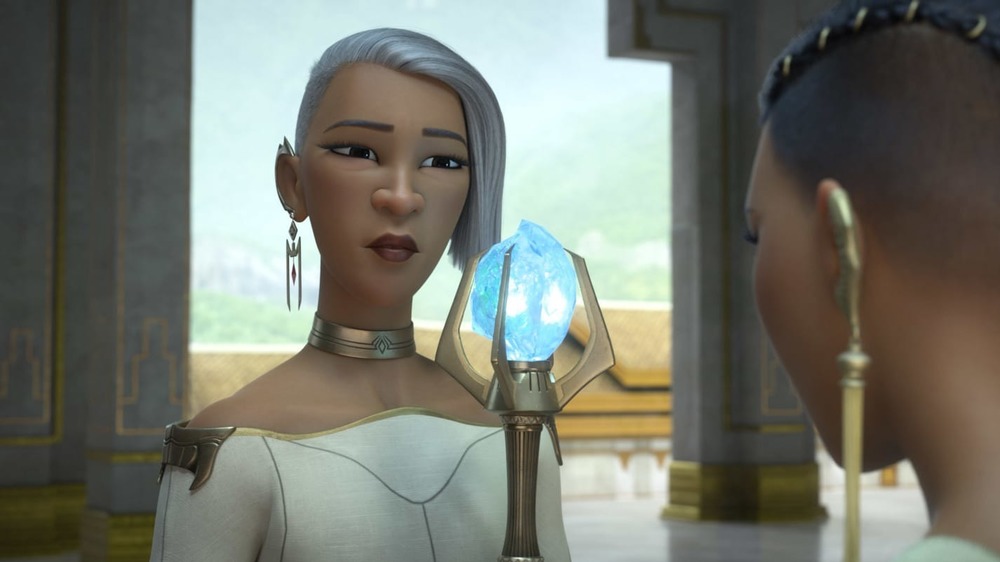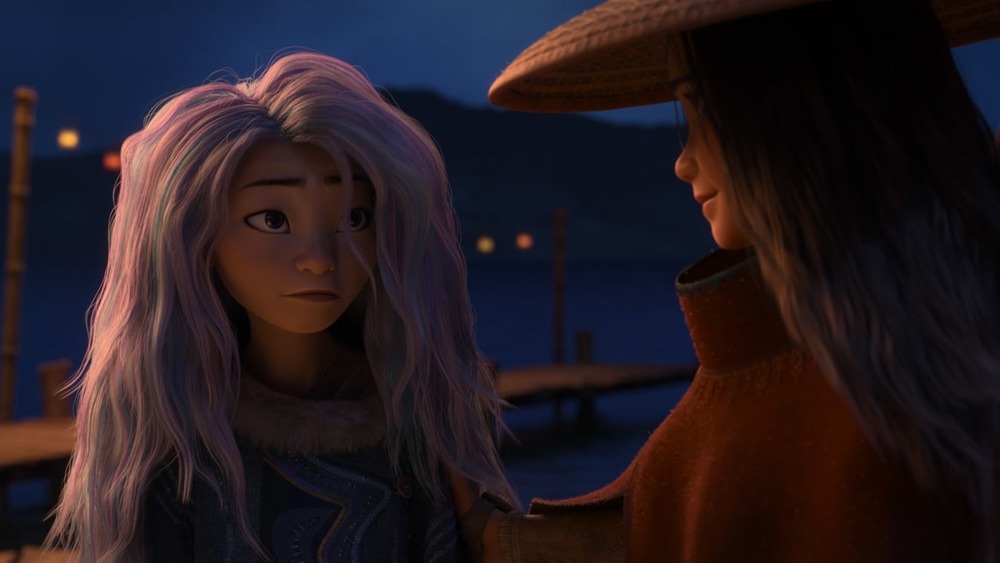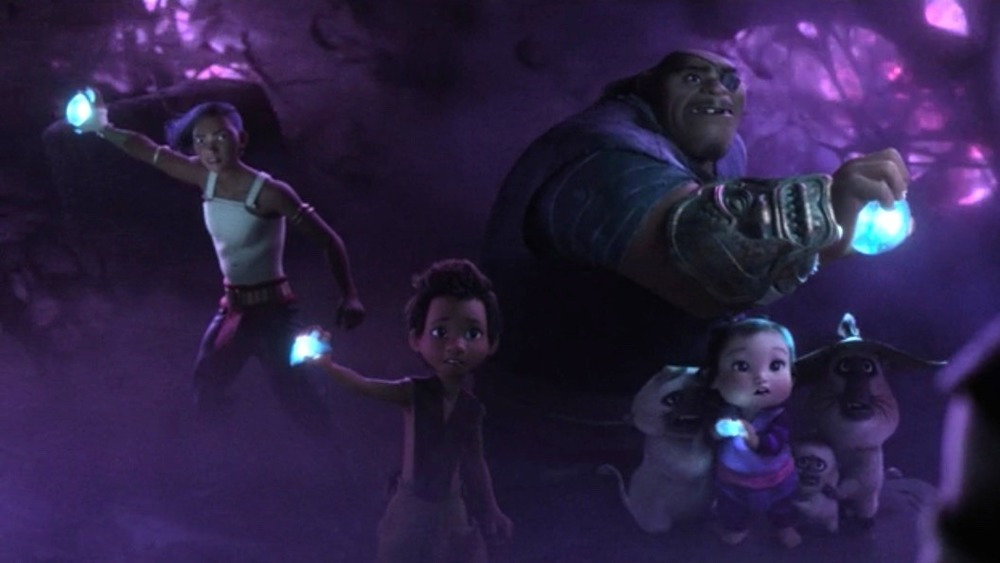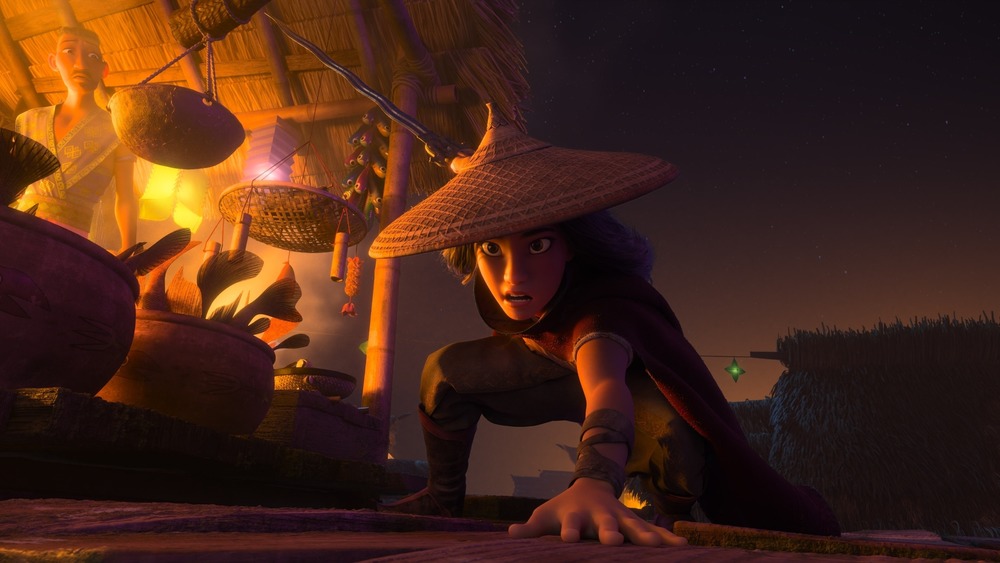Things Only Adults Notice In Raya And The Last Dragon
After being bumped from its original premiere date of November 25, 2020 thanks to the COVID-19 pandemic, Raya and the Last Dragon finally hit theaters and the Disney+ streaming service — the latter for a $29.99 Premier Access price tag — on March 5, 2021. Featuring a predominantly Asian American cast, led by Star Wars: Episode VIII – The Last Jedi's Kelly Marie Tran as Raya and The Farewell star Awkwafina as Sisu, the titular last dragon, and set in a world inspired by the cultures of Southeast Asia, Raya and the Last Dragon already holds some cultural significance that adult viewers are more likely to pick up on than their children even before viewing the film.
But the aspects of Raya and the Last Dragon that will be far more apparent to adults than children don't stop at what kind of story is being told or whose voice talents are being used to tell it. Not only will older viewers likely pick up on story details and plot questions that kids are more inclined to overlook, but there are also some interesting parallels to other stories and long-term implications of Raya and the Last Dragon that are sure to spark some curiosity or amusement in perceptive grown-ups. Here are a few of the things only adults will notice in Disney's Raya and the Last Dragon.
Raya's version of history is probably missing some pieces
As Raya and the Last Dragon opens, we see Raya riding her giant roly-poly companion Tuk Tuk (who appears to be some sort of massive armadillo/pill bug hybrid) through a barren wasteland dotted by human statues. Raya then explains how things got like this — 500 years before, dragons and humans lived together peacefully in a paradise called Kumandra. But their harmonious way of life was destroyed when malevolent spirits called the Druun invaded, turning everyone they touched to stone. The dragons fought to protect the humans, and finally prevailed over the Druun — but all of the dragons were turned to stone in the process save the last one, Sisu, who disappeared.
It's a beautiful story, but adult viewers are going to realize that it seems to have glossed over a few important parts. While Raya presents Kumandra as "paradise" and its people living in perfect harmony, Sisu later explains that the Druun were born of human discord. If that's the case, then Kumandra must not have been the idyllic, conflict-free world that Raya made it out to be. What's more, Raya eventually realizes that trust is the silver bullet needed to defeat the Druun, which makes you wonder — why was trust in such short supply 500 years ago? Could it be that the contentious feelings which led to the wars that divided Kumandra after the dragons disappeared actually began long before the Druun ever showed up?
The story of Kumandra feels almost religious
Regardless of your own background, most people can probably agree that for millennia, billions of humans have relied on their religious beliefs to explain where we came from, how the world works, and to determine our purpose in life. So adults will probably not miss that the story of the dragons that Raya tells at the beginning of Raya and the Last Dragon holds a lot of parallels to a religious creation story.
Raya's story begins with humanity living in an idyllic world, watched over by benevolent magical creatures who served as the source of water and rain, and thus all life. It is even implied that the humans worshipped the dragons in the reverent way they bow and raise their hands to their foreheads whenever they're in their presence. When the Druun arrive, it's the dragons who sacrifice themselves in order to give humanity another chance, and dragons who ultimately return centuries later to restore the world to its former glory. Even during the 500 years that dragons are gone, human civilization and conflict all centers around vying for the favor they perceive as being bestowed by the last bit of dragon magic. Kids will likely take it all at face value, but for many adults, the religious parallels will be too strong to miss.
Raya and Namaari's relationship feels like it could be something more
When Raya and Namaari (Gemma Chan) first meet as children, the two instantly bond over their shared interest in — what else? — dragons. Almost immediately, they're sharing secrets and dreaming about their future — but it turns out to all be a ruse, orchestrated by Namaari's home tribe of Fang so Raya will lead her to the dragon gem. From that moment on, Namaari acts as an antagonist — until the end of the film, when Raya realizes that the key to defeating the Druun is trust, and literally puts her fate in Namaari's hands by giving her Heart's piece of the dragon gem.
It's a moving arc for both characters — and could hold additional significance, from a certain point of view. Some adult viewers may notice that while Raya never gets an explicit love interest in the film, her relationship with Namaari hits many of the same beats often reserved for romantic relationships. The way they meet closely mirrors Anna and Hans' first encounter in Frozen, when Hans is explicitly set up as Anna's love interest (before later being revealed as a villain), and their interactions throughout the film can easily be interpreted as flirtatious. Even Raya's voice actor, Kelly Marie Tran, sees their relationship as romantic, telling Vanity Fair that while Disney's official stance says nothing about Raya's romantic inclinations, "I think if you're a person watching this movie and you see representation in a way that feels really real and authentic to you, then it is real and authentic." Young kids probably won't think much at all about the implied subtext of Raya and Namaari's relationship, but for older viewers yearning for representation, their connection may feel particularly meaningful.
The pose the Druun freeze people in is foreshadowing the solution
When the terrifying Druun show up in Kumandra, they take the form of smoky monsters giving off an ominous purple glow that overtakes people and turns them into stone. Yet for most of the people the Druun transforms into statues, they don't freeze in the position they were in when the Druun first wrapped around them. Rather, most of the time, the statues end up standing with their hands cupped in front of them, as if offering up an invisible gift to a recipient only they can see.
While the position of the people affected by the Druun is never explicitly addressed in the film, their cupped hands are actually a subtle way at foreshadowing the eventual solution that will be found by Raya and her friends. Not only does the cupping motion hint at the involvement of Sisu, a water dragon, and also demonstrates unity, in all of the statues standing in the same position, but it also seems to indicate an action of offering up something important to someone else. This is what Raya eventually realizes she has to do, putting her trust in Namaari and giving her the Heart tribe's fragment of the dragon gem. This is also what the dragons did 500 years before, when they gave the gem to Sisu in the first place. It turns out that the only way to defeat the Druun is with an act of unity and trust — which the Druun was subtly telling its victims all along.
Why didn't anyone go looking for Sisu before?
In the story Raya tells of the history of Kumandra, after Sisu sacrificed herself, the surviving human tribes went to war with one another over possession of the dragon gem, which held the last remnants of dragon magic. However, at some point along the way, someone had to have noticed that Sisu's body was missing. Unlike the rest of the dragons, who had been turned to stone, Sisu just vanished. What's more, somehow, a legend began that Sisu had been washed away down the river, and that her body lay at one of its many ends. This is the story Namaari tells Raya early in the movie — which turns out to be true, since it leads Raya to find Sisu six years later.
And yet even though none of these stories would've existed without someone having an idea about Sisu's fate and making a record of it, it appears that no one ever thought to go looking for the heroic dragon. Even while all of the tribes of Kumandra were at each other's throats over the final scrap of dragon magic, it didn't seem to occur to anyone to seek out the real live dragon that was very much within reach. It seems bizarre that Raya was the first to go searching for Sisu, but every indication points to the conclusion that she was. Kids may not think to ask why, but adults will likely wonder what kept anyone else from seeking out Sisu's resting place.
Raya tipped her hand
After Raya locates Sisu, she is understandably wary of letting anyone find out that her travel companion is a real live dragon. Even after making friends with young Boun (Izaac Wang) and the formidable Tong (Benedict Wong), she is reluctant to let either of them know her friend's true nature. And yet, for some reason, early in the film, Raya doesn't hesitate before telling Namaari that she's found the dragon Sisu. Unlike Boun and Tong, who understandably don't think twice about a human named Sisu, Raya introduces her to Namaari in direct response to Namaari's question about whether Raya was looking for the dragon. "I actually was looking for Sisu," Raya says. "And guess what? I found her."
This seems risky for a few reasons. First is obviously the very reason why Raya never tells anyone else that Sisu is actually a dragon — she's afraid that they may try to control her. But Namaari actually poses an additional risk — she's a "dragon nerd" just like Raya, who should presumably be familiar with dragon lore. Considering that Sisu got her transformation ability from one of her siblings, it would be reasonable to assume that there's some record of dragons being able to transform into humans. If anyone was going to realize that Raya's "human" friend Sisu was actually a dragon in disguise, it should've been Namaari. That she doesn't is lucky for Raya, but you have to wonder why Raya risked her realizing the truth in the first place.
Baby Noi is a deeply sad character
During Raya's visit to Talon Tribe to locate their piece of the dragon gem, she comes across a seemingly abandoned baby — only to realize the baby is a con artist intended to keep her distracted while a trio of Ongis rob her. Despite their dishonest beginnings, the baby and her monkey-like companions throw in their lot with Raya, and wind up being indispensable in the adventure that follows. Eventually, we learn that the baby's name is Noi, and it quickly becomes clear that she's uniquely precocious, able to both move and think on the level of someone many times her age.
But while Noi and the Ongis mostly serve to provide comic relief, adults will likely realize the profound tragedy inherent in a baby who has had to learn the skills of someone much older and fend for herself because she lost her entire family. In the real world, such a child would've likely perished if they weren't taken in by an older caretaker; the option to be adopted by a trio of benevolent sticky-fingered primates wouldn't really exist. In Raya and the Last Dragon's fantasy world, Noi is able to forge a new path for herself as a street-smart trickster and thief, but adults won't be able to ignore the deep sadness of a small child forced to grow up too fast because if she didn't take care of herself, no one would.
Why isn't everyone stealing gem pieces?
Numerous times throughout Raya and the Last Dragon, characters question Raya's quest to collect the fragments of the broken dragon gem. She's always elusive in her answers, not wanting to give away the secret that she's located Sisu, the last dragon, and is trying to reassemble the gem in order to defeat the Druun and bring back all the people they've locked in stone. Raya's fear is that after centuries of conflict, the other tribes would probably short-sightedly attempt to seize Sisu's power for themselves rather than work together for the betterment of all.
However, while Raya's reluctance to reveal the nature of her quest to anyone else is understandable, why is she the only one hunting gem pieces in the first place? After all, the catalyst for all of the conflict is that each of the tribes wanted the original dragon gem for themselves, and that after it was broken, they all took whatever they could get in the hopes of claiming some of its power. Rather than everyone wondering why Raya is collecting gem pieces, isn't the bigger question why no one else is? It seems that rather than being mystified by her actions, the other tribe leaders should assume that Raya's goal is to amass more power for the Heart tribe. Kids will likely take the constant questions about Raya's motivations in stride, but adults will wonder why no one else thought to do the exact same thing.
The plague analogy hits differently during a pandemic
When Sisu is explaining the nature of the Druun to Raya and Boun, she describes them as "a plague born of human discord." While that line was scripted long before the COVID-19 pandemic, there's no denying that it probably lands differently than originally intended when watching the film while wearing a mask in a theater capped at 50% capacity, or at home because you haven't engaged in indoor recreation in public places for a year due to the highly contagious virus sweeping across the world. While the coronavirus doesn't turn anyone literally to stone, it has felt for many as though they are frozen in time, unable to move forward until something is done to halt the spread of the disease.
What's more, the way Raya and her friends eventually defeat the Druun also carries particular weight when viewed during a pandemic. Raya realizes that instead of insisting on an every-man-for-himself approach, the only thing that will work is if the members of the different tribes present a united front, trusting one another to do the right thing and accepting that in order to achieve the best outcome for Kumandra as a whole, it may require individual sacrifice. Kids will probably be able to accept the story of the Druun as mere fantasy, but in a world where vaccine and mask debates are still raging on every front, adults may not be able to overlook the obvious parallels.
The Druun aren't gone at the end
At the end of Raya and the Last Dragon, after all of the last representatives of each of the five tribes have given their dragon gem pieces to Namaari, their combined trust and cooperativeness revives the dragon gem, which in turn erupts with magic, wipes out the Druun, and revives all of the people and dragons who have been turned to stone. Raya and her companions are reunited with their lost loved ones, and Kumandra is once again restored to the paradise it once was.
Except... it may not actually be that simple. Just as Raya probably glossed over some less-than-shiny bits in her account of history, the ending of Raya and the Last Dragon may not be quite as happily ever after as it appears. When Sisu is explaining the nature of the Druun, she says "they've always been here waiting for a moment of weakness to attack," like "the opposite of dragons." This implies that although the people of Kumandra may drive off the Druun for a time, they're never truly gone; they just go dormant until a new opportunity arises for them to strike. For the dragons, it took 500 years until the five tribes could come together and bring them back. Hopefully it will take even longer for them to fall apart enough for the Druun to find their way back, but adults will realize that as rosy as the ending appears, the threat of the Druun always remains.
This plot feels familiar to superhero fans
Imagine this: a group of gems, each imbued with immense magical power, fall into the wrong hands, and as a result, vast numbers of people are supernaturally wiped out in the blink of an eye. Half a decade later, a group of survivors come together, determined to locate all of the scattered gems and use them to bring back all the people they've lost. The effort involves some tricky heist work, but despite some bumps along the road, they're finally able to reassemble all of the gems. Ultimately, through their teamwork — and the heroic sacrifice of their leader — they're able to reverse the dark magic of the past and bring back everyone they've lost, although they'll never get back the years in which some were gone while their loved ones aged without them.
Sound familiar? Obviously, that's a broad summary of the plot of Raya and the Last Dragon, but it's also the basic storyline of 2019's Avengers: Endgame, the massive climax to a decade's worth of Marvel Cinematic Universe adventures. Obviously the two aren't exactly the same — among other things, the time jump in Raya is six years, not five, and the Druun are a very different type of villain than Thanos — but it's still hard to ignore the parallels. Kids may not notice some of the big picture similarities, but if their parents are superhero fans, they may get a kick out of just how much overlap there is.
